Last updated on March 20th, 2024 at 06:16 am
Before you start website design and development, you need to make some important decisions.
For one, you must choose a domain name, hosting platform, and website theme. Your choice will determine how profitable your website will become.
These first stages of web design are key, and anyone who dreams of building a successful website should plan and design it from the ground up. Good design and layout improves user experience and increases conversions.
We introduced you to the building blocks of a website, such as HTML, CSS, and PHP in Part 1 of this website design guide. This second part will cover domain names, the domain name system (DNS), and web hosting in detail.
What Is a Domain and How Does It Work?
A domain is a unique, human-readable string of characters that serves as the internet address for your website. For example, Truehost.ph is the unique domain for this website, and no other site can have that exact domain.
Domains belong to whoever registers them with a domain registrar. For example, Truehost.ph is an accredited domain name registrar in the region. You can check domains, search for unused domains, and register them right here on our website.
If you want to know who owns a particular domain, find its registration information by conducting a WHOIS search. Use our free WHOIS search tool on our international website for information about any currently registered domain names.
Types of domains
To understand domains, we have to talk about URLs.
But first, note that a domain is the name of a website, which is different from the site URL. For example, Truehost.ph is a domain, as is truehost.com.
On the other hand, a URL is a more complete definition of a domain name that a browser can use to visit the website. It’s the actual internet address of that website. For example, https://truehost.ph is the URL of the domain Truehost.ph.
A URL has different parts, which we talked about in the previous section. If you haven’t been there already, find that information in the image below.
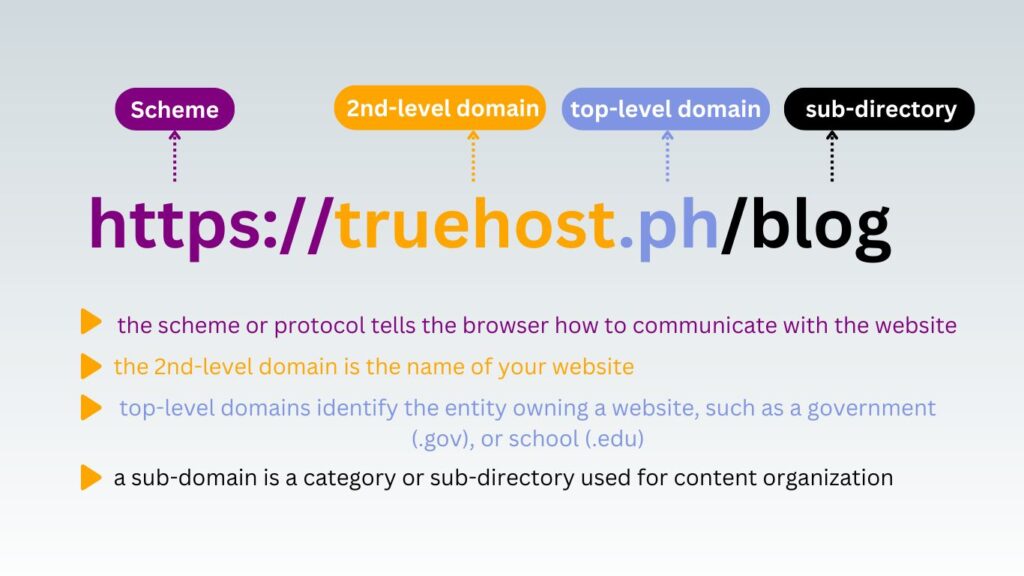
When people talk of types of domains, they’re usually thinking about Top Level Domains (TLDs). That’s the part that comes after the domain name, such as .com, .net, .gov, .org, .edu, and .ph.
As you can see, TLDs reflect the type of organization that owns the website. There are actually five main types of TLDs:
- Generic TLDs (gTLD) – these are the most common and popular domain extensions. Although anyone can have a gTLD, some of them are restricted. Examples include:
- .org
- .com
- .net
- .biz
- .blog
- .tv
- .site
- .company
- .tech
- .info
- .store
- .shop
- Here’s the complete list of over 1,200 gTLDs as of 2024
- Sponsored TLDs (sTLDs) – these are restricted to and supervised by organizations such as schools and governments. They include:
- .edu
- .gov
- .cat – for the Catalan community
- .museum
- .travel
- .int – for organizations established by international treaties
- .asia
- .mil – for US defense systems and government
- .aero – for industries in the air transport industry
- .post – for postal services
- Country-code TLDs (ccTLDs) – these are established for countries or territories. Each ccTLD has a managing organization to meet local, cultural, legal, and linguistic requirements. Examples include:
- .ph – the Philippines
- .my – Malaysia
- .cn – China
- .ca – Canada
- .de – Germany (Deutschland)
- .co.uk – the UK
- .in – India
- Infrastructure TLD – the .arpa TLD is the only domain in this category. It stands for the Address and Routing Parameter Area and is managed by IANA for the Internet Engineering Taskforce. It is only used for technical or infrastructure purposes
- Test TLDs (tTLDs) – these are reserved and left unused for the purposes of testing or to minimize confusion and conflict. Examples are:
- .test – for testing sites
- .example – used as a placeholder in documentation
- .invalid – used for invalid domains
- .localhost – used in local networks
After top-level domains we have second-level domains. That’s simply the domain name part, such as “Truehost” in “https://truehost.com”. Some URLs also have country code second-level domains, such as .co.uk used for domains in the United Kingdom or .gov.au for Australian government sites.
This domain name hierarchy is shown in the image below. You’ll notice that we’re essentially defining the parts of a URL from right to left, but without the “http” part.
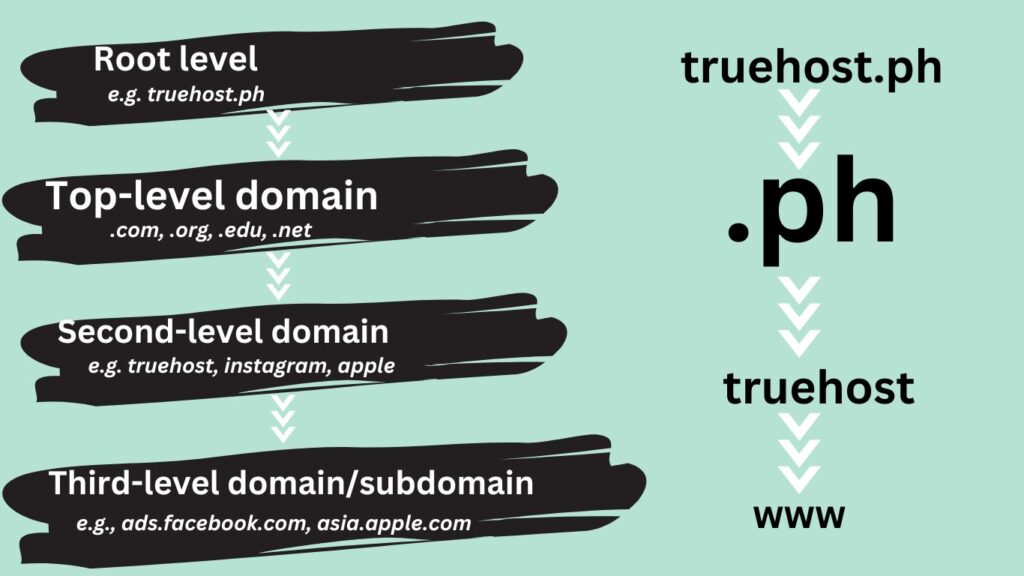
Following this system, third-level domains are the portion of the domain that comes before the actual domain name.
For example, in the domain www.truehost.com, the www part is a third-level domain. That’s different from the protocol (http or https), which is not found in a domain but in a URL.
You don’t really need a second-level domain to have a working domain name, but some websites use it to define a subdomain.
What is a subdomain?
Large websites sometimes need to carve off an entirely different section of the site for various reasons. This part of the website still operates under the main domain name, but without having to deal with complex URL links and redirections.
A website with the domain www.example.com may have the subdomain blog.example.com for their blog section. In this case, .blog is the third-level domain.
Subdomains are very popular with e-commerce sites because you can have different product lines or categories under subdomains, which makes organization much easier.
Subdomains also allow you to dedicate a part of a site to resources (tutorials or downloads), or even build completely different sites under the same domain.
Expert tip: Choosing the right domain name helps users identify and remember your brand more easily. Keep the domain name as brief as possible, and don’t add any foreign characters. Moreover, domains that are exact matches for what users search for will bring more traffic and conversions, hence more money.
Who manages domain names?
Domain names are owned and managed by domain name registries, which also manage all top-level domains (TLDs).
Domain registries maintain records of who owns each domain, what IP addresses are associated with it, and how to handle queries or requests directed to the domain.
Domain registries are different from domain name registrars. Domain registrars are the companies that sell domain names to users. They handle the commercial side of domains on behalf of registries and also provide technical support to customers.
In return, domain name registrars are allowed to add a small markup to the domain price and make a little profit this way.
Domain name trading
You may have heard already, but you can make money buying and selling domain names. Also called domain flipping, trading domains is possible because some domain names that are cheap now may have more demand and thus command higher prices later.
Also, some domain names are of special interest to companies. For instance, the nestle.com.ph is valuable to Nestlé Philippines, thought not as much to another company. They could pay you a premium to control that domain if you happened to own it.
Sometimes this can cause brutal domain grabbing and selling. Some people grab expired domains before their owners have a chance to renew them, knowing they can negotiate a fat price with owners who become desperate to get back their site.
Getting the right domain names could net you a handsome profit. For example, .ph domains are becoming very popular thanks to the rise of e-commerce.

It’s a good idea to buy hot domain names before prices skyrocket. Even if you don’t intend to sell a domain, you may need it when you eventually set up a website.
Remember, domain names are valuable digital assets that can be grabbed in seconds. For instance, king.ph and team.ph recently sold for $1,000 each.
For more information, see our guide on how to sell a domain name.
Who really owns domains?
Nobody actually owns a domain name, they only lease them for a set period. That’s why domain subscriptions can expire and be purchased by someone else.
All domains and internet addresses (IPv4, IPv6) belong to the The Internet Corporation for Assigned Names and Numbers (ICANN). This whole domain registration and trading system works under the global oversight and authority of ICANN.
In fact, ICANN is the global administrator of all IP addressing systems. It maintains the central database of IP addresses and controls the supply of new ones. ICANN also coordinates the operations of all domain registries worldwide to ensure no conflicts in IP addressing.
As part of its role, ICANN has a special department called the Internet Assigned Numbers Authority (IANA) which manages the root nameservers of all TLDs worldwide.
What are root nameservers?
Root nameservers are DNS servers that translate human-readable domain names into IP addresses for computers. They’re part of the complex Domain Name System (DNS), which we’ll cover in the next section.
DNS simplifies the process of identifying and finding everyone on the internet. At the top of the grid, ICANN owns and allocates IP addresses to every region. These are assigned to Regional Internet Registries (RIRs), which can allocate them to organizations, national registries, and end users.
On the distribution side, Internet Service Providers (such as PLDT) and website hosting companies (such as Truehost) are allocated blocks of IP addresses, which they can further distribute to individual and business end users.
Here in the Philippines, dotPH is the Official Domain Registry for the .ph top-level domain. dotPH is responsible for the registration, control, and policing of all domains and IP addresses in the region.
What Is DNS and How Does It Work?
DNS is like the phonebook of the internet. It is a large database of all the domain names in the world and their corresponding IP addresses, as well as other information such as who owns the domain and how requests to particular domains are handled.
In practice, ICANN delegates the work of maintaining DNS records to authoritative and TLD servers which are distributed geographically to every region. This system breaks up the global records into smaller, more manageable networks of DNS databases.
The DNS system is best understood by explaining how a URL is converted into an IP address through the DNS lookup process.
The DNS Record Lookup Process
Although the DNS system is quite complex, the way it works is simple. When you enter a URL in your browser, your computer gets that URL translated into an IP address and then looks up that IP address in the DNS system. This process is known as DNS resolution.
The first request to resolve the URL is sent to a local server called a resolving nameserver. Such servers are usually maintained by large companies and ISPs. They use results cached from previous searches to return a quick result. Results for the most commonly visited sites, such as Google.com or Instagram.com, usually end at this level.
If the resolving nameserver doesn’t find a record, it sends the request to a recursive nameserver. Also called a public DNS or recursive resolver, this server conducts a DNS lookup to find the right records. It starts by checking its own cache, and if it doesn’t find a record, it sends the request to the root nameserver.
The recursive server also sends the request to a TLD nameserver, and finally to an authoritative nameserver. Once the IP address is obtained from either, the recursive server caches the record so that the next request for the same domain name won’t have to go through the whole lookup process again.
The image below shows the DNS lookup simplified.
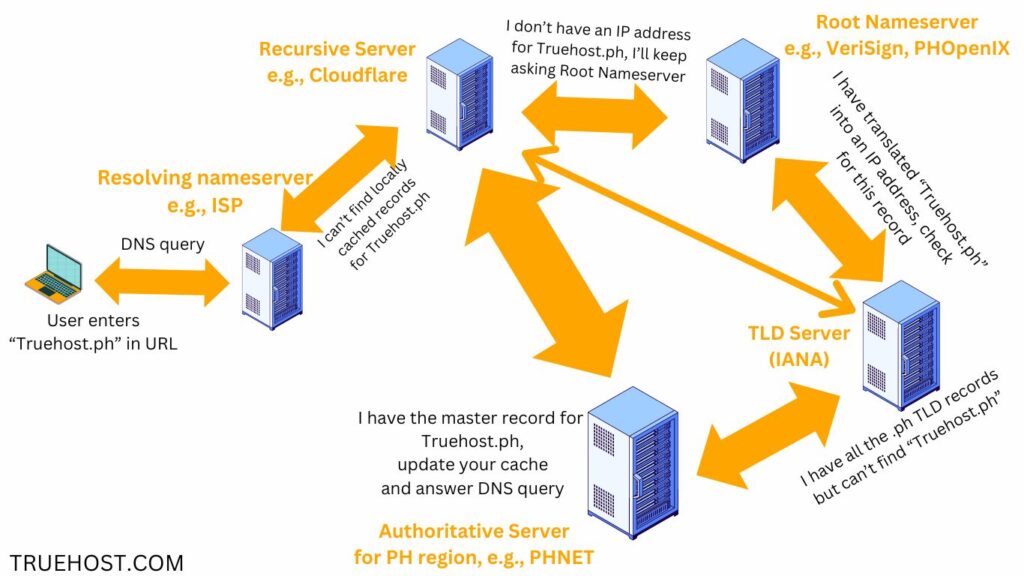
This system helps improve DNS efficiency and speed. The servers at the top of the hierarchy only need to respond to queries that the servers below can’t handle. It also means internet traffic doesn’t need to travel too far away.
Having such a distributed system improves redundancy and reduces the risk of the entire DNS system going down. However, mishaps can happen, such as when Facebook was down for over 6 hours on October 4, 2021, due to the loss of DNS routes for its authoritative nameservers.
In addition to domain registration, you also need to host your website with a reliable and trusted website hosting company.
What is Website Hosting?
A website host is the computer server and internet infrastructure that stores a website and makes it accessible on the internet.
Ideally, a website hosting server should run continuously to maximize availability. It should also prioritize security to protect your website from the many threats it faces from the internet.
Other features of a good website host include:
- High performance – fast memory and processor ensure the website loads quickly and effortlessly even when there are thousands or millions of users
- Backup – regular backups should be kept to minimize the chances of losing the website in case of a disaster
- Bandwidth – this is the rate of data flow from the website servers to clients within a specific amount of time. A higher bandwidth allows faster page load times, especially when there are many people using the site
- Redundant power and connectivity – website servers are computers like any other, so they will go offline when there’s no power
Website servers should have two or more power and internet backups to minimize the chances of going offline. The industry standard is 99.9% uptime, minimum. That means less than 10 minutes of downtime a week or just under 9 hours a year, which can be difficult to maintain without a lot of infrastructure.
Where to host your website in the Philippines
With such performance requirements, website servers must have high-quality hardware, stable software, constant maintenance, and top-notch security. That takes a lot of work and resources and is often done by very large organizations and companies. You can then lease some of that infrastructure to host your website.
Rather than host your own website (which you can) or private servers, it makes much better sense to rent server space. That’s what it means to buy hosting services.
Even better, you can bundle website hosting and domain registration into one convenient package.
A hosting and domain bundle makes it much easier and cheaper to start a website. Plus, you get lots of additional goodies such as a personalized email address, SSL certificate, and technical support whenever you need it.
Given how important website hosting is to your website’s success, you must make sure you find a trusted web hosting company in the Philippines. Learn more about hosting services for beginners.
What’s the best website hosting company in the Philippines?
Bad website hosts cause problems such as downtimes, cyber-attacks, configuration errors, server overload, connection failures, and many more. When problems like these occur, you lose customers who can’t reach your site.
That’s bad, but it gets worse.
Some of the largest hosting service providers are accused of predatory tactics. They lure you in with freebies like SSL certificates and emails to get you hooked to their service. When when your domain expires, the prices suddenly shoot up and you have no choice but to pay up or start over again with a different hosting company.
Some companies are so bad that they surprise customers with price hikes even before the domain or hosting subscription expires.
Such hosting companies don’t care about their customers. To them, losing a few clients is no big deal. You can read more horrors stories about .
We can’t emphasize enough the importance of hosting your website with a reliable and trusted website hosting company. The most important thing to look for in a website hosting company is a customer-first approach.
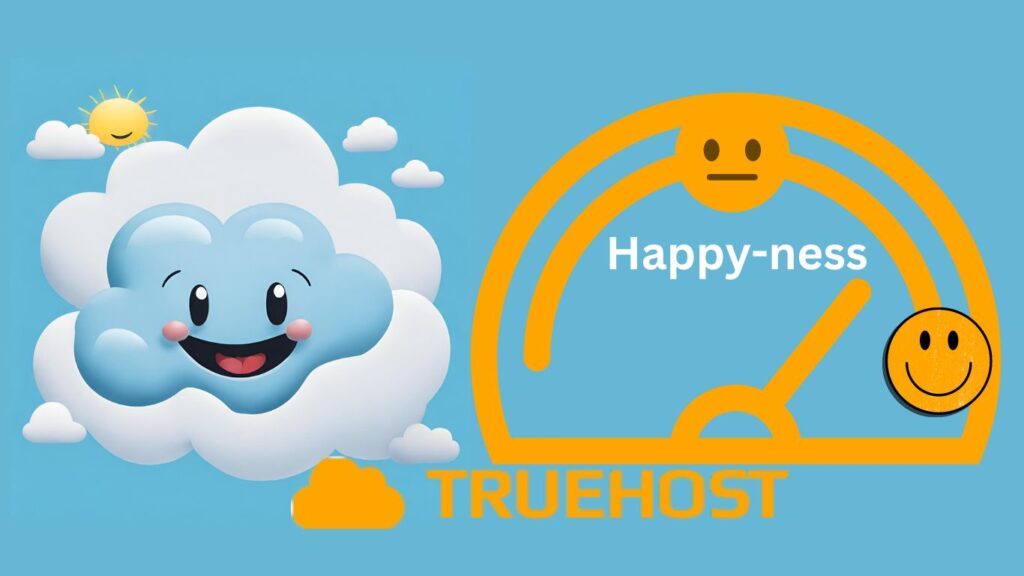
Find a hosting company that values you
Most people look at the wrong things when looking for website hosting services. Although speed, pricing, and performance matter, most hosting companies can offer you a good deal on all three.
Instead, the quality of customer service is the most reliable means of finding the best web hosting company.
One way to use this method is to contact customer support and ask about available services. You can tell right away if the company is right for you by how helpful the support team is, how professional and knowledgeable they are, and how quickly they respond to queries.
Commitment to customer satisfaction ensures that you get the best performance, no matter what hosting tier you pay for. No more careless configuration errors, accidental deletions, unscheduled downtimes, unusable backups, or unreachable support.
For more information, read our guide on how domains and hosting services work.
Expert tip: Server performance can vary greatly depending on whether you’re using a shared server (cheap), VPS server (better performance and average prices), or a dedicated server (expensive). As your website grows, make sure you upgrade your hosting plan to account for the increased traffic and database size.
Best Website Hosting Company in the Philippines
Truehost is one of the fastest-growing website hosting companies in the world because of our commitment to customer satisfaction. We value every client and work hard to keep our customers happy, no matter what hosting plan they pay for.
That’s because Truehost’s mission is to help small businesses grow. In addition to website hosting services, we also have a variety of tools designed for small businesses.
One of those tools is our free website builder, Olitt. Olitt comes with in-built SEO features, DNS management, free SSL certificates, analytics tools, and more.
This commitment has made Truehost one of the most reliable and trusted cloud and hosting services provider in the Philippines, Canada, South Africa, Kenya, Nigeria, India, and the UK.
If you’re looking for a website hosting provider that you can trust, talk to us today. We’re even available on Twitter and Instagram!
Or, continue to learn more about website design in this series.
 Web HostingCost-effective shared hosting solutions
Web HostingCost-effective shared hosting solutions Reseller HostingStart your own hosting business without tech hustle
Reseller HostingStart your own hosting business without tech hustle Affiliate ProgramEarn commission by referring customers to our platforms
Affiliate ProgramEarn commission by referring customers to our platforms cPanel HostingHosting powered by cPanel (Mostly user friendly)
cPanel HostingHosting powered by cPanel (Mostly user friendly) Windows HostingOptimized for windows based-applications and sites
Windows HostingOptimized for windows based-applications and sites Domain SearchFind and register available domain names in seconds
Domain SearchFind and register available domain names in seconds All DomainsExplore and register domain extensions across the world
All DomainsExplore and register domain extensions across the world Domain Transfermove your domain to us with zero downtime and full control
Domain Transfermove your domain to us with zero downtime and full control Whois LookupLook up domain ownership, expiry dates and registrar information
Whois LookupLook up domain ownership, expiry dates and registrar information .com DomainSecure the most recognized domain for global credibility
.com DomainSecure the most recognized domain for global credibility VPS HostingScalable virtual servers. Full root access. Faster speed.
VPS HostingScalable virtual servers. Full root access. Faster speed. Managed VPSNot a tech expert? Choose our fully managed VPS server.
Managed VPSNot a tech expert? Choose our fully managed VPS server.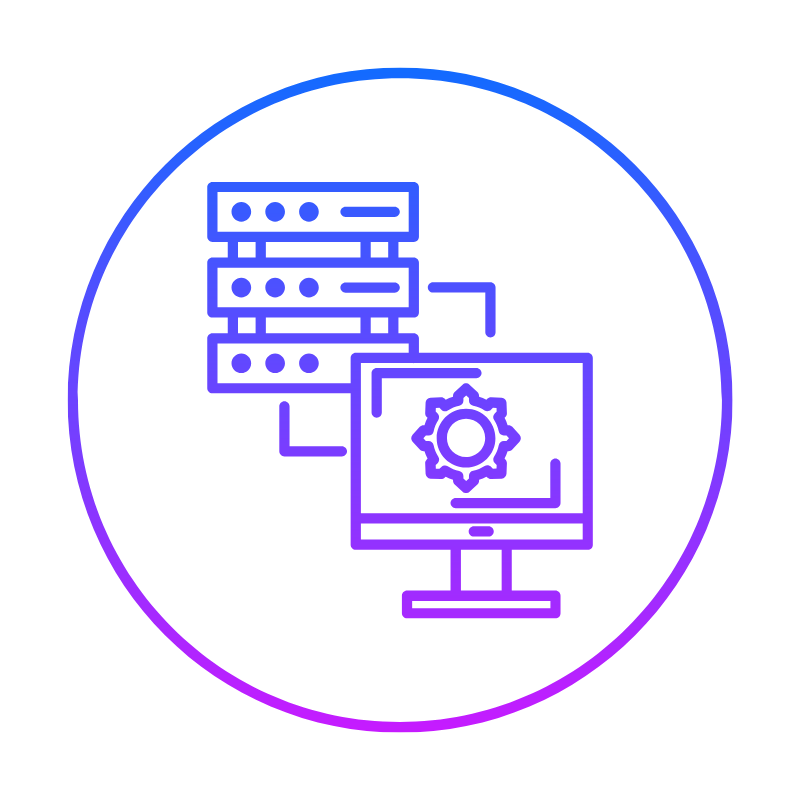 Dedicated ServersGet the full power and complete control of your own physical server.
Dedicated ServersGet the full power and complete control of your own physical server.
